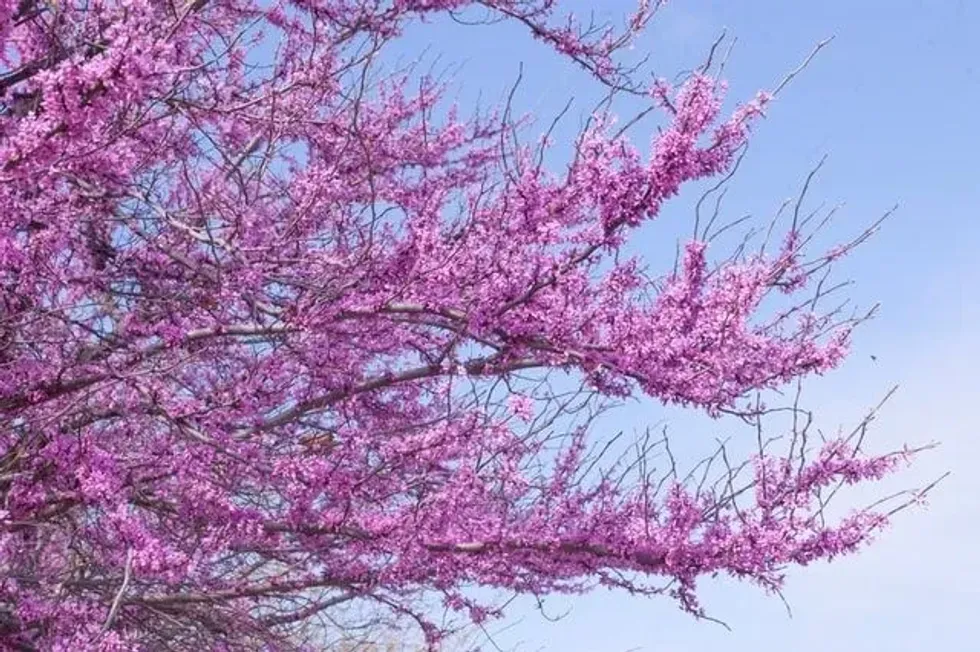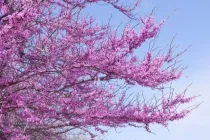Redbud trees are well known for their bright purple and pink flowers that color North America's parks and forests in the spring.
These fun facts about redbud trees for kids will help you get to know the beautiful tree, and where you can find it in the wild (although they are definitely not hard to spot).
If you've ever wondered about why redbud trees are only found in eastern North America and not the west, or why people sometimes call them the Judas tree, then you are about to find out.
And if you're looking for even more nature facts, then these African elephant facts and these chloroplast facts might be of interest.
Basic Redbud Tree Facts
The eastern redbud is very easy to spot in the summer months by its bright color. These facts will help you to identify the trees without doubt any time from spring to fall.
1. Eastern redbud trees typically will grow between 20 and 30 feet tall.
2. They usually spread between 26 and 33 feet wide.
3. Most of the trees have a short trunk, which is often twisted, and their branches spread wide.
4. When an eastern redbud tree is five years old it will have grown to around 16 feet tall.
5. The color of the bark of the redbud tree is dark brown and very smooth when the tree is young.
6. As the tree grows older, their bark becomes scaly and has ridges.
7. Sometimes the redbud tree has patches on its bark that are maroon colored.
8. The leaves of the tree are simple and heart shaped, with a thin and papery feel. Sometimes the leaves are a little bit hairy on the underside of them.
9. The winter buds of the redbud tree are very small and dark red colored.
10. The twigs of the Eastern redbud tree are thin and have a zigzag shape. They are very dark brown and have lighter spots on them.
11. The redbud tree grows purple and pink flowers that appear in spring and summer time.
12. The flowers of the tree grow on bare stems before leaves grow.
13. Sometimes the flowers even appear on the trunk of the tree.
14. The fruit of the tree look like pea pods. They are flat, dry and brown.
15. The tree will bear seeds in the fall, between the months of August and October.
16. The heart-shaped leaves of the redbud tree are between two and six inches in length.
17. In the summer the leaves turn a dark green color, and in the fall they turn bright yellow.

Where Are Redbud Trees Found?
If you don't live in the east side of the United States, you might not see very many of the eastern redbud tree species. We are going to let you know exactly where you can find them.
18. Redbud trees are mostly found in the east of North America.
19. They are found all the way from Ontario, Canada to the north of Florida in the United States.
20. You can usually find the eastern redbud tree in hedgerows and they are also native to mixed forests.
21. Because it looks very pretty, the redbud tree is often used as a decorative tree in people's gardens and in parks.
22. It is difficult to grow the trees in the western part of the United States, anywhere from Colorado to Kansas, because there isn't enough rain.
23. There has been a special strain of the tree developed that has successfully grown in Columbus, Wisconsin. It is known as the Columbus strain.
24. Redbud trees are good at adapting, and can survive with most types of soil and landscape, and with either a lot or a little bit of sun.
25. The tree usually prefers to grow in a moist and well drained soil location.
26. If you plant a redbud tree in the full sun, it will need to be watered regularly.
27. It is often best to plant the eastern redbud tree in partial shade rather than full sun, so it doesn't need to be watered as often.
28. If you plant them in the sun rather than the shade, the eastern redbud will produce a lot more blossoms in early spring.

Interesting Redbud Tree Facts
Learn some interesting info about the eastern redbud that you didn't know before. These redbud tree facts will definitely teach you something new about this deciduous tree.
29. The redbud tree is the state tree of Oklahoma, it became the state tree in the year 1937.
30. The trees are pollinated by bees with long tongues, like carpenter bees or blueberry bees.
31. Sometimes green twigs from the trees are used to season meat, which is why the eastern redbud can sometimes be called the spicewood tree.
32. Native Americans would eat redbud flowers either boiled or raw. They also ate the roasted seeds of the tree.
33. When their flowers bloom, redbud trees look like a pink firework.
34. Usually the redbud tree will split into two or three close to the ground, meaning lots of the trees will have a multi-trunk shape with a rounded crown and arched branches.
35. Each year, the redbud tree will reach a growth rate of between 13 and 24 inches.
36. The scientific name used for the redbud tree is the Redbud Cercis Canadensis.
37. Redbud Cercis Canadensis comes from the Greek word 'kerkis' which means "a weaver's shuttle" and describes the shape of the fruits of the tree.
38. The 'Candensis' part of Redbud Cercis Canadensis refers to Canada, because the tree is native to Canada, however this was a bit controversial as it is actually more commonly found in the United States today.
39. The most common diseases that affect the redbud tree are fungal infections.
40. The fungal infections that the tree can get include dieback, leaf spots, verticillium wilt and canker. These are quite common in this kind of plant.
41. The Eastern redbud can often be referred to as the Judas Tree, after Judas Iscariot from the Bible, who was one of Jesus' apostles.
42. Though trees like a bit more shade when they are in their early stages, the older the tree gets the more the branches need full sun to thrive.
43. Redbuds can resist some drought, but if salt is added to their soil they will die.
45. The pink and purple flowers of the trees attract hummingbirds.
46. Older trees are more likely to get diseases than trees in their early years of life.
Here at Kidadl, we have carefully created lots of interesting family-friendly facts for everyone to enjoy! If you liked our suggestions for awesome redbud tree facts then why not take a look at some facts about the seaside and learn about how mushrooms grow with these mushroom facts?










